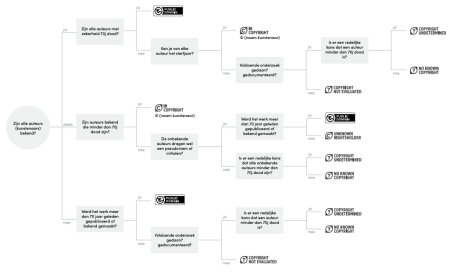Decision trees for informed use of copyright
27 Jan 2022At the end of 2021, we prepared a series of useful tools to help you easily discover the rights status of your collection pieces. At the start of 2022, we’re going a step further and providing a series of decision trees as the focal point of our project: Tools for dealing with copyrights and usage restrictions on cultural content. This will help institutions to streamline how they assess the rights status of their heritage objects.
Rights can form an obstacle to making valuable heritage accessible and available. Documentation for rights metadata can help institutions avoid the risk of breaking any laws and legal proceedings when publishing reproductions on the web. To support these institutions, we’ve developed tools and good practices which we’re putting to the test in a number of pilot projects. Currently on the agenda? Decision trees for M Leuven and Kusterfgoed and COMEET heritage bodies, and the Dutch translation of the Europeana Rights Labelling Flowchart.
Decision what?
Decision trees help people in organisations that manage collections to make the best possible decision about a heritage object’s rights status, and to do so quickly. At the end of the process, you can use the metadata to decide which heritage objects you can publish online with a minimal risk of prosecution. The decision trees take a wide range of rights into account, and you don’t need to be an expert on rights to get started. Handy!
Two pilot projects under the microscope
When drawing up a decision tree, it’s important to take into account any legal aspects that apply to specific collections. In our pilot projects with Kusterfgoed and COMEET heritage bodies, for example, we focused on how volunteers registered a collection of photos and postcards. Information about rightsholders was often completely absent from this collection, but its age suggested that the images would still be protected by copyright.
This resulted in a hands-on decision tree that volunteers without lots of prior knowledge can use during the registration process. The step-by-step decision-making process means materials can be made accessible in the image database as quickly as possible without too much risk. What’s particularly special about this pilot project?
We also used the heritage bodies’ collections as a test case for content that could potentially be made accessible using the so-called out-of-commerce exception to copyright. These are works that are still protected by copyright, but which are no longer or have never been available commercially.
Because information about rightsholders is often missing in this case, the rights status is sometimes a big unknown. We therefore compensate for this with rights statements that make visitors to the platform co-responsible.
We developed three decision trees for M Leuven: one for determining the rights status of collection pieces, one for their reproductions, and a final one for photos of the museum’s events and work. These decision trees are a useful tool for internal employees at M Leuven to consistently determine the rights status for registration in their DAM system, and provide each image with a name.
Bonus content
In the framework of this rights project, we also translated Europeana’s Rights Labelling Flowchart into Dutch. This is a handy flowchart for heritage institutions that are considering making their collections accessible online, and possibly also available for re-use. Check it out here! (link in Dutch)

